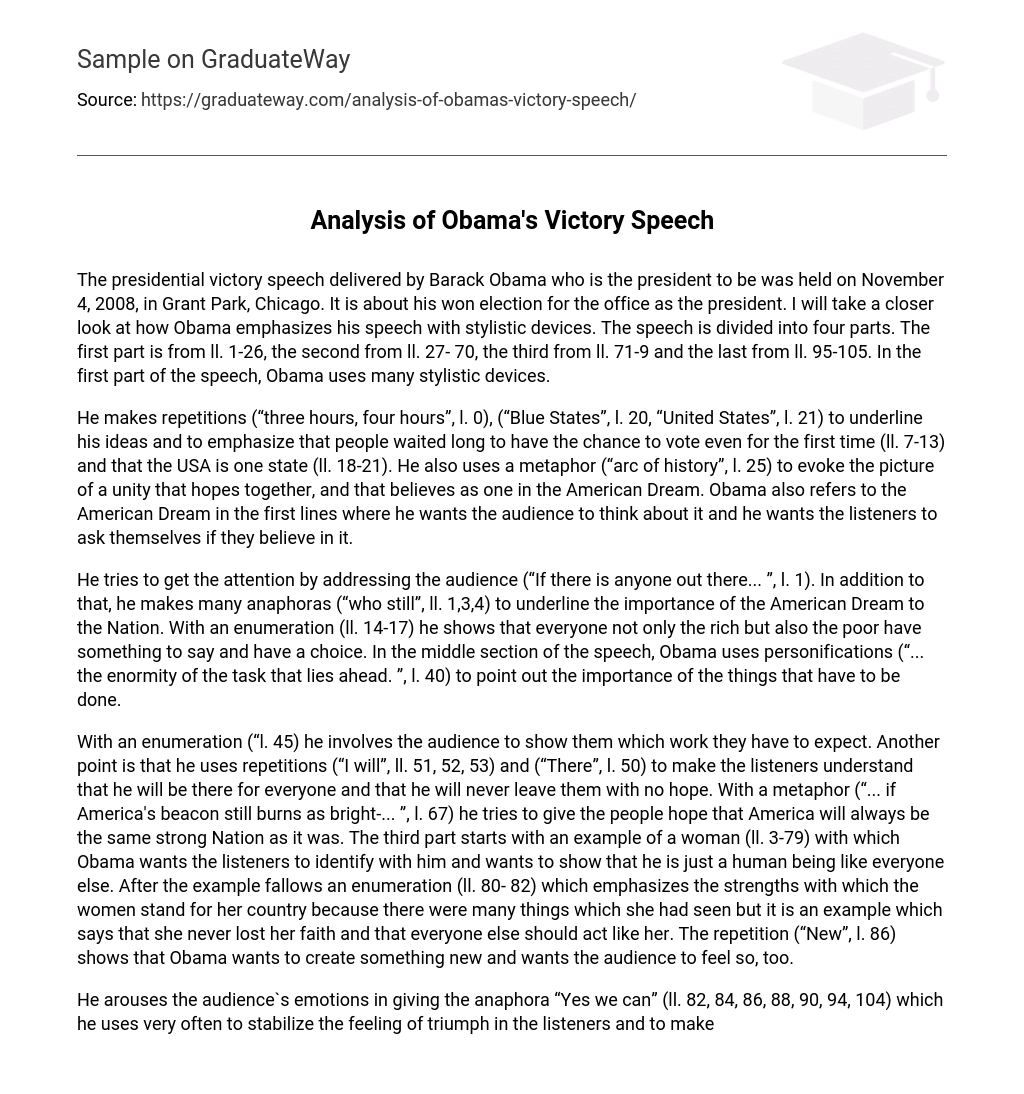The presidential victory speech was given by Barack Obama, who was the president-elect at the time, on November 4, 2008, at Grant Park in Chicago. The speech mainly focuses on Obama’s successful election as the president and examines how he employs stylistic devices to enhance his delivery. The speech can be divided into four sections: lines 1 to 26, lines 27 to 70, lines 71 to 99, and lines 95 to 105. Throughout the first part of the speech, Obama utilizes numerous stylistic devices.
The author utilizes repetitions in the text, such as “three hours, four hours” (line 0), “Blue States” (line 20), and “United States” (line 21), to underscore his ideas and emphasize that people waited a long time to vote, even for the first time (lines 7-13), as well as to highlight the unity of the USA as one state (lines 18-21). In addition, he employs a metaphor in the form of the phrase “arc of history” (line 25) to portray a collective hope and belief in the American Dream. Obama also mentions the American Dream at the beginning, aiming to encourage the audience to ponder it and contemplate their personal belief in it.
The speaker attempts to capture the attention of the viewers through his use of audience address (“If there is anyone out there…”, line 1). Additionally, he employs several anaphoras (“who still”, lines 1, 3, 4) to emphasize the significance of the American Dream to the Nation. Through an enumeration (lines 14-17), he illustrates that not only the wealthy but also the impoverished have a voice and choice. In the middle portion of his speech, Obama utilizes personifications (“… the enormity of the task that lies ahead.”, line 40) to highlight the importance of the tasks that must be accomplished.
The speaker engages the audience by using an enumeration (“l. 45) to indicate what they can expect. Additionally, he employs repetitions (“I will”, ll. 51, 52, 53) and (“There”, l. 50) to emphasize that he will be there for everyone consistently and without fail. Through the use of a metaphor (“… if America’s beacon still burns as bright-… “, l. 67), he instills hope in the people that America will remain a resilient nation. The third section begins with an illustration of a woman (ll. 3-79) that Obama uses to foster identification with the audience and illustrate his own humanity. Furthermore, he aims to demonstrate that, like this woman, he is a regular person. Following this example is an enumeration (ll. 80-82) that highlights the woman’s qualities of strength and her unwavering faith in her country despite the adversities she has faced. The repetition of “New” (l. 86) conveys Obama’s desire to initiate change and encourages the audience to embrace this new perspective.
The audience’s emotions are stirred by his frequent use of the anaphora “Yes we can” (ll. 82, 84, 86, 88, 90, 94, 104). This repetition serves to solidify a sense of triumph and encourages the listeners to believe in their ability to initiate change. Obama employs an enumeration (ll. 91-92) to highlight significant global events and emphasizes that even the seemingly small act of a woman casting her vote has historical importance. To prompt reflection on personal actions and future progress, Obama poses rhetorical questions (“…what change will they see?” l. 97, “What progress will we have made?” ll. 97-98). In the final sentences, Obama utilizes anaphoras (“This is our”, l. 99) and repetitions (“to”, ll. 99, 100, 101, “we”, l. 102) to underscore the significance of his concluding statements and to captivate readers with important ideas.
In his speech, the speaker endeavors to awaken readers and effectively convey his message. He emphasizes that fear of losing should not deter individuals, as effort can lead to victory. The concluding sentence conveys gratitude to the audience and implies that God oversees all. The repetition of “God” in line 105 reinforces the speaker’s genuine concern for the well-being of all. In summary, Obama employs various stylistic devices and examples throughout the speech to ensure comprehension and convey his message, which consistently relates to the American Dream.





